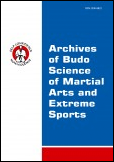2016, Volume 12, Issue 1
The correlation of general and special physical fitness indices with body weight and composition 13–15-year-old female judo athletes
Beata Wolska1, Marek Adam1, Piotr Klimowicz2
1Wychowania Fizycznego, Akademia Wychowania Fizycznego i Sportu, Gdańsk, Poland
2SWFiS, Politechnika Białostocka, Białystok, Poland
Author for correspondence: Beata Wolska; Wychowania Fizycznego, Akademia Wychowania Fizycznego i Sportu, Gdańsk, Poland; email: beata.wolska[at]wp.pl
Full text
Abstract
Background and Study Aim: At the stage of comprehensive training of juvenile judo athletes physical fitness, weight and body composition are subject to factors both natural biological development, as well as the strong influence of training loads. The study aims is the correlation between general and special physical fitness indices and somatic indices in 13–15-year-old female judo athletes.
Material and Methods: Fourteen female judo athletes of the provincial team of Pomerania (in Poland) in the group of youngsters and younger juniors were subject to examination. The subjects’ mean age was 13.9 ±1.1 years and the average training experience 5.5 ±1.9 years. To determine the somatic characteristics: the weight and body composition in the form of adipose tissue (FAT), lean body mass (FFM), body water (TBW) – the Tanita Body Composition Analyzer was used. To assess general physical fitness was applied International Committee on the Standardisation of Physical Fitness Test (ICSPFT). The level of special effort capacity was assessed by means of Special Judo Fitness Test (SJFT) and the Igumienov’s test.
Results: The results of a correlative analysis between somatic indices and ICSPFT achievements did not reveal a single correlation indicating a very high level of interdependence. It was observed that lower values of the body height, FAT (kg), FAT (%) and higher values of FFM (%) and TBW (%) corresponded to lower HR values after 1 minute since completion of the SJFT test, which suggests faster restitution after a specific load related to performing the test.
Conclusions: The examined female judoists were characterized by high indices of general physical fitness, which could prove that judo is an appropriate measure to stimulate comprehensive physical development of youth.
Key words: Special Judo Fitness Test, physical preparation, Igumienov test, stage of training, training load





